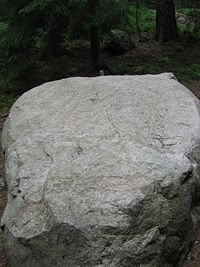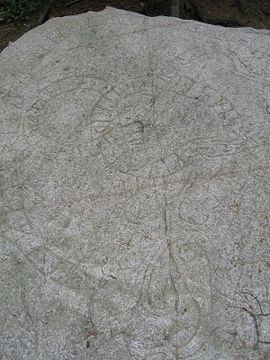
Uppland Rune Inscriptions 101, 143 and 147
Encyclopedia

- Main article Jarlabanke RunestonesJarlabanke RunestonesThe Jarlabanke Runestones is the name of c. 20 runestones written in Old Norse with the Younger Futhark in 11th century, Uppland, Sweden.They were ordered in the by what appears to have been a chieftain named Jarlabanke Ingefastsson and his clan , in Täby...
The runestones known as U 101, U 143 and U 147, are located in south-western Täby
Täby
Täby is a trimunicipal locality and the seat of Täby Municipality in Stockholm County, Sweden, with 58,593 inhabitants in 2005. It is also partly located in Danderyd Municipality and Sollentuna Municipality...
, in the parishes of Sollentuna and Täby
Täby
Täby is a trimunicipal locality and the seat of Täby Municipality in Stockholm County, Sweden, with 58,593 inhabitants in 2005. It is also partly located in Danderyd Municipality and Sollentuna Municipality...
, in Uppland
Uppland
Uppland is a historical province or landskap on the eastern coast of Sweden, just north of Stockholm, the capital. It borders Södermanland, Västmanland and Gästrikland. It is also bounded by lake Mälaren and the Baltic sea...
, Sweden
Sweden
Sweden , officially the Kingdom of Sweden , is a Nordic country on the Scandinavian Peninsula in Northern Europe. Sweden borders with Norway and Finland and is connected to Denmark by a bridge-tunnel across the Öresund....
. They are all in the style Pr4 and thus dated to the period 1060-1100 during which they were carved in connection with the construction of a road from Hagby to Ed at Edsviken
Edsviken
Edsviken is an elongated, narrow inlet of the Baltic Sea running through the Swedish municipalities of Danderyd, Solna and Sollentuna. Edsviken ranges from Stocksund and Bergshamra in the south to Edsberg in the north. The inlet is about long with an area of approximately ; its maximum depth is...
. They belong to a group of c. 20 runestones called the Jarlabanke Runestones
Jarlabanke Runestones
The Jarlabanke Runestones is the name of c. 20 runestones written in Old Norse with the Younger Futhark in 11th century, Uppland, Sweden.They were ordered in the by what appears to have been a chieftain named Jarlabanke Ingefastsson and his clan , in Täby...
that are connected to the local chieftain Jarlabanke and his clan
Norse clans
The Scandinavian clan or ætt was a social group based on common descent or on the formal acceptance into the group at a þing.-History:...
. Together with the Broby bro Runestones
Broby bro Runestones
At Broby bro in Uppland, Sweden there are six runestones. U 139, U 140 and U 151 still stand by the road, but U 135, U 136 and U 137 have been moved a distance away from the road....
and the Hargs bro runic inscriptions
Hargs bro runic inscriptions
The Hargs bro runic inscriptions, or U 309, U 310 and U 311, are 11th century Younger Futhark inscriptions in Old Norse on bedrock in Skånela Parish, Uppland, Sweden....
these particular runestones, however, centre around the female matriarch of the clan called Estrid
Estrid
Estrid was a rich and powerful 11th century Swedish woman whose long family saga has been recorded on five or six runestones in Uppland, Sweden. This Estrid was the maternal grandmother of the chieftain Jarlabanke of the Jarlabanke clan...
, who was the grandmother of Jarlabanke.
The runemaster
Runemaster
A runemaster or runecarver is a specialist in making runestones.Most early medieval Scandinavians were probably literate in runes, and most people probably carved messages on pieces of bone and wood. However, it was difficult to make runestones, and in order to master it one also needed to be a...
of the Snottsta runestone called U 329, where an Estrid and her brother Ragnfast are mentioned, was Fot who also made the runestones for the Jarlabanke clan. This strongly suggests that Estrid was born in Snottsta (also spelled Snåttsta), married Östen of Täby and married for the second time in Harg near Snottsta.
The rune stones that are treated in this article tell that both Estrid's sons Ingvar (whom she had with Ingvar in Harg) and Ingefast (whom she had with Östen in Broby) had died.
The runestones give further information on her family. She evidently became quite old and is mentioned on the same runestones as her grandchildren, Häming and Jarlabanke. It also appears that she had had seven children and returned to the vicinity of Täby, and probably because there she had most of her children and grandchildren.
When Stockholm County Museum
Stockholm County Museum
Stockholm County Museum is a museum covering the history of Stockholm County in central-eastern Sweden except central Stockholm ....
made an archaeological excavation at Broby bro
Broby bro Runestones
At Broby bro in Uppland, Sweden there are six runestones. U 139, U 140 and U 151 still stand by the road, but U 135, U 136 and U 137 have been moved a distance away from the road....
, in 1995, they found three graves. The three were buried in the Christian tradition, that is, with the head facing west; also, they were not burned and there were few gifts. Some coins found helped to date the graves to the 11th century. One of the graves was of an old woman and she lay buried beside a barrow that one of the Broby bro Runestones
Broby bro Runestones
At Broby bro in Uppland, Sweden there are six runestones. U 139, U 140 and U 151 still stand by the road, but U 135, U 136 and U 137 have been moved a distance away from the road....
says was raised for Estrid's first husband Östen. The buried woman can have been Estrid.
U 101

Broby bro Runestones
At Broby bro in Uppland, Sweden there are six runestones. U 139, U 140 and U 151 still stand by the road, but U 135, U 136 and U 137 have been moved a distance away from the road....
) and Ingvar probably refers to the son she had with the husband by the same name (both Ingvars are mentioned on the Hargs bro runic inscriptions
Hargs bro runic inscriptions
The Hargs bro runic inscriptions, or U 309, U 310 and U 311, are 11th century Younger Futhark inscriptions in Old Norse on bedrock in Skånela Parish, Uppland, Sweden....
).
Transliteration of the runes into Latin characters
× henmikr × auk × iarlabaki × þaiR × litu × braut + ryþia × auk × broaR × kiara × eftiR × faþur × sin × auk × estriþ × eftiR suni × sina × inkifast × auk × inkuar + kuþ × hialbi × ant × þaiRa ×Transcription into Old Norse
HæmingR ok Iarlabanki þæiR letu braut ryðia ok broaR giæra æftiR faður sinn ok Æstrið æftiR syni sina Ingifast ok Ingvar. Guð hialpi and þæiRa.Translation in English
Hemingr and Jarlabanki, they had the path cleared and the bridges made in memory of their father; and Ástríðr in memory of her sons Ingifastr and Ingvarr. May God help their spirits.U 143

Transliteration of the runes into Latin characters
× iurun × lit × kiara ×× broaR × iftiR × boanta ×× sen ×× auk ×× henminkr × auk × iarlabanki × eftiR × ink[i]fast × estriþ × iftR × inkuar × alkoþan × trenkTranscription into Old Norse
Iorun let gærva broaR æftiR boanda senn ok HæmingR ok Iarlabanki æftiR Ingifast, Æstrið æftiR Ingvar, allgoðan dræng.Translation in English
Jórunnr had the bridges made in memory of her husbandman; and Hemingr and Jarlabanki in memory of Ingifastr; Ástríðr in memory of Ingvarr, an excellent valiant man.U 147

Personal pronoun
Personal pronouns are pronouns used as substitutes for proper or common nouns. All known languages contain personal pronouns.- English personal pronouns :English in common use today has seven personal pronouns:*first-person singular...
þaR is the feminine form for "they", in Old Norse
Old Norse
Old Norse is a North Germanic language that was spoken by inhabitants of Scandinavia and inhabitants of their overseas settlements during the Viking Age, until about 1300....
, and it shows that Jórunn had the stone made together with another lady. The fact that it is dedicated to Estrid's son Ingvar and the fact that there are remains of the runes tr point to Jórunn's mother-in-law Estrid as the second lady who had the stone made.

